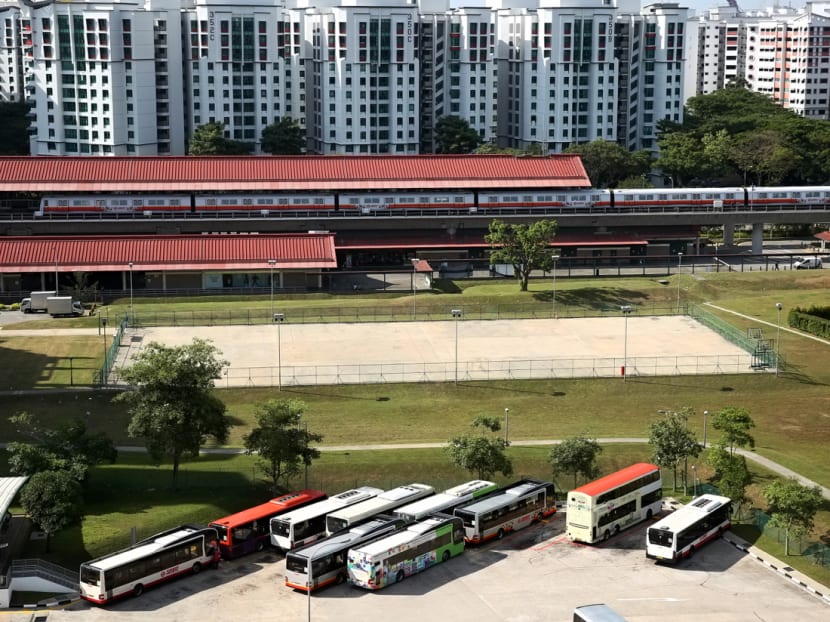Public transport fares could rise after revision to fare formula
SINGAPORE — Commuters may have to fork out more for MRT train and bus trips in the future, as a new component which takes into account changes to operating costs will be introduced to the formula for calculating public transport fares.

Sembawang MRT station. Public transport fares may go up soon with a revised fare formula that addresses the ‘widening gap’ between cost and fares, the Public Transport Council said on Thursday (March 22). Photo: Nuria Ling/TODAY
SINGAPORE — Commuters may have to fork out more for MRT train and bus trips in the future, as a new component which takes into account changes to operating costs will be introduced to the formula for calculating public transport fares.
Announcing the revised fare formula on Thursday (March 22), the Public Transport Council (PTC) said the new component, called Network Capacity Factor (NCF), will track the structural changes to operating costs as a result of the changes in capacity and usage attributed to the growing rail network. This means that with NCF, fares will increase if the capacity growth in the public transport network – which is decided by the authorities – outstrips ridership growth.
The NCF will address the “widening gap” between costs and fares, which is “not sustainable for any public transport network”, said the body regulating public transport fares. The PTC said that this is on top of “significant subsidies” that the Government will provide over the next five years, which are estimated at around S$9 billion.
The latest revision to the formula will be applied from this year to 2022.
When asked if fares are likely to increase at the end of 2018, or after, PTC chairman Richard Magnus said: “I don’t know, but I have the (remaining) 3.2 per cent (possible reduction which has been rolled over to this year’s fare review exercise) in my pocket to moderate anything that might happen.”
Mr Magnus was referring to the quantum carried over from last year’s fare review exercise, when the PTC considered a 5.4 per cent fare reduction based on the old fare formula, but only implemented a 2.2 per cent fare reduction allowance through discounts.
Asked if the new formula will translate to the public bearing the brunt in the case of inefficient planning by the Government, Mr Magnus said there had been “basic prudence” on the part of the Government.
He said: “Assets are not cheap… I don’t think the Government will say I want to inject this even if there is no demand. So I think that is a careful, intentional expenditure when there is a need.”
Calling the NCF a “sensible” addition, Transport Minister Khaw Boon Wan said the fare formula change is a “useful update” to keep the public transport system sustainable.
“The PTC’s challenge is to balance the interests of many stakeholders… When changes are significant, some adjustments to fares, whether upwards or downwards, will ensure fairness between taxpayers and commuters,” said Mr Khaw in a Facebook post.
Public transport capacity has increased by about 25 per cent from 2012 to 2017, with the addition of more than 1,000 new buses and a 74km increase in the length of the rail network, said the PTC.
As a result, transport operators have seen their annual operating costs go up by over S$900 million between 2012 and 2016, while the growth in fare revenue of around S$230 million over the same period covered only over a quarter of the increase.
Pointing out that the Government has stepped in to provide substantial subsidies to cover the operating expenditure shortfall, the commission added the revised formula will make it more nimble and responsive to industry cost changes as Singapore’s public transport landscape undergoes transformation.
The current formula used since 2013 is pegged to changes in the Core Consumer Price Index (CPI), national wage averages (Wage Index or WI), and cost changes in electricity and diesel (Energy Index or EI).
As part of this revision, tweaks have also been made to the weightages of two of the indexes, the CPI and EI, in the formula. Explaining the respective dip and rise in the EI and CPI weightages, the PTC said in 2016, energy costs only amounted to 9 per cent of the public transport network’s operating cost. The bulk went to manpower costs (42 per cent), depreciation costs (24 per cent) and maintenance expenses (13 per cent).
FARES EXPECTED TO RISE
While the PTC did not say if public transport fares will increase with this revision, transport analysts told TODAY that they expect fares to go up.
While the final fare adjustment quantum will be announced in the third quarter of 2018, transport economist Walter Theseira of the Singapore University of Social Sciences said the NCF will most likely end up being an “increase factor” in the next fare review, and “probably in the near future”.
This is due to flat ridership growth in recent years due to stagnant population growth, huge growth in the popularity of private hire cars, as well as significant capacity and service quality growth, added Dr Theseira.
He said: “The only way in which it won’t be positive will be basically if ridership grows a lot, or if the public don’t mind more crowding and reduced service quality for lower fares. But the question is if the public is going to say that? I am not too sure. (They) always want more convenient rides, more frequent service.”
However, he said that the NCF is important to recognise the “real cost” in providing more convenience to commuters. “That cost is basically the cost of running trains and buses, which are carrying air – what happens when you expand service quality,” said Dr Theseira.
Transport expert Tham Chen Munn, director of business development at PTV Asia-Pacific, a traffic solutions firm, does not think that it will translate to a fare increase in the near term as the Government is also encouraging people to use public transport.
But he noted that that the phased opening of the new Thomson-East Coast Line from 2019 may tip the quantum, albeit very gradually. This is because changes in capacity and usage of new rail lines will only be computed into the NCF 18 months after they are opened to allow for ridership to stabilise.
The announcement on Thursday is the third time the fare formula has been revised, and it comes a year after the PTC announced a review of the fare adjustment formula and mechanism.
HOW FARES ARE CALCULATED
- The NCF is calculated by measuring the change in place kilometres (total distance covered by the operated bus and train trips) per passenger kilometre (total distance travelled by each commuter) over the preceding year, with equal weightage given to both bus and rail modes.
- Current fare formula: Fare adjustment = 0.4 core CPI + 0.4WI + 0.2EI - 0.5 per cent
- Revised fare formula: Fare Adjustment = 0.5 core CPI + 0.4WI + 0.1EI - 0.1 per cent + NCF








